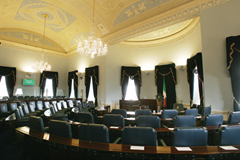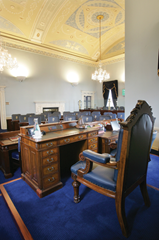The Seanad: a case for abolition?
 Peter Cheney considers Seanad Éireann’s structure, history and possible future. The upper chamber faces abolition or comprehensive reform, pending a referendum result.
Peter Cheney considers Seanad Éireann’s structure, history and possible future. The upper chamber faces abolition or comprehensive reform, pending a referendum result.
‘Scrap the Seanad’ was a catchy general election slogan. While not a vote-winner in itself, it chimed with the hostile public mood against ‘establishment’ politics. Government policy now proposes abolition, subject to support in a referendum, but others claim that the Dáil would become less accountable as a result.
It’s an unprecedented constitutional move. Never before has the public been asked to remove part of the state’s system of government, which makes the debate over the Seanad’s purpose a crucial one.
The main advantage of the 60-member chamber is that it gives voice to a wider range of views than those expressed to the Dáil. Conversely, most of the last Seanad’s members ended up there after losing out at the ballot box.
All parties admit that they use the Seanad to rebuild their members’ political careers, even if the public has decided otherwise. Thirty-four members of the outgoing Seanad were unsuccessful Dáil candidates in 2007. Twenty-three of the 49 senators elected in April 2011 had run for the Dáil in February. The Taoiseach’s patronage fills the remaining 11 places.
The party breakdown so far is 18 Fine Gael, 14 Fianna Fáil, Labour nine, Sinn Féin three and five independents.
Structure
As history shows, the Seanad is an example of how independent Ireland retained aspects of the Westminster model and adopted the Catholic concept of social order.
In 1920, the Government of Ireland Act established a House of Commons and Senate in each part of Ireland. Its successor, the Free State Senate, gave extra representation to the Protestant minority but was considered undemocratic by Éamon de Valera. It was therefore abolished in 1936 and the current version was established by the following year’s constitution.
The Seanad is more democratic compared to the British House of Lords where 676 of the 789 members are appointees (86 per cent); the remainder are hereditary peers or Church of England bishops.
Seanad panels reflected the Catholic Church’s thinking of different vocations among the laity, which would provide ‘experts’ in each field. Pope Pius XI called for the “reconstruction of the social order” in his 1931 encyclical, partly as a response to communism with the vocations working together to achieve that.
Panel candidates can be nominated by Oireachtas members or representative groups. The electorate, though, is entirely political (i.e. 883 city and county councillors, 166 TDs and 45 outgoing senators) so panel members now tend to be party activists. The Constitution’s Article 19 allows for direct elections from selected vocational groups.
Limiting representation to the two largest universities has proved hard to justify. A referendum in July 1979 allowed the Government to create more university seats but none have been formed since then.
The Seanad is free to amend or initiate any Bill except for a Money Bill, on which it can make recommendations to the Dáil instead. It chooses its own Chairman (Cathaoirleach) and Vice-Chairman (Leas-Chathaoirleach) while the Leader of the Seanad heads up the group of government senators.
With the economic situation taking priority, there appears to be no great rush on this front.
“The Government has not decided formally on holding any constitutional referendum this year,” Enda Kenny told the Dáil on 12 April. He added that ministers were considering whether a referendum could be held later this year alongside a presidential election. He has formally requested legal advice from the Attorney- General on the wording of that question.
The 1979 referendum is the nearest precedent, when the proposal was overwhelmingly passed (92.4 per cent) but on the lowest turnout for any referendum in the state’s history (28.6 per cent).
In the meantime, a critique of the Government’s plans has started to take shape, not least from senators. The debate now has two clearly defined sides: pro-abolition and pro-reform.
Each main party supports or suggests the end of the current chamber. Fine Gael claimed that second chambers were either dominated by parties (if elected) or unaccountable (if unelected) in its ‘New Politics’ policy document.
Labour’s ‘New Government, Better Government’ paper says: “It is simply not possible to identify any bodies or sections in our society that deserve … to be singled out as constituting a special and separate electorate, entitled to vote for their own separate House of the Oireachtas.”
Ironically, those parties’ candidates are standing for election to a body which they hope to abolish. Fine Gael TD Charles Flanagan has pointed out that the Government is obliged to hold Seanad elections, regardless of its policy, and says the new House should be allowed to run its full term.
Fianna Fáil concluded, in its general election manifesto, that the Seanad is “struggling to justify its existence” but recognised that its debates are “frequently more thoughtful than those in the Dáil”. The party would support abolition if its other proposals for reforming politics were enacted.
The Sinn Féin manifesto opposes the Seanad “in its current form” but suggests a new directly elected upper house, with all-island elections to panels and no Taoiseach’s nominations. Emigrants could also vote, if registered with an Irish embassy or consulate.
On cost grounds, abolition would directly save around €4.5 million in senators’ salaries and €2.5 million in their expenses and reduce the Oireachtas’ overall budget (€123 million in 2009). Fourteen of the 27 EU member states have one-chamber (unicameral) parliaments.
Reform
However, the Seanad’s defenders warn that, far from improving democracy, abolition would delete an important check on the political class.
Retiring senator Eugene Regan (Fine Gael) had a “very satisfying” term and prefers broadening the franchise for panel elections, although this should still be on a national basis.
The Seanad, he told eolas, provides “an important democratic safeguard” and provides “a body where people who have a real contribution to make have been brought in.”
Regan, a senior counsel, repeatedly questioned Bertie Ahern’s evidence to the Mahon Tribunal. He was also the first Oireachtas member to raise Willie O’Dea’s admission of perjury. Ministers would often reject his amendments but “you ultimately saw it reflected in the legislation which was ultimately adopted.”
Seanad service is “not a bad testing ground” for the Dáil. David Norris, he notes, has criticised this attitude but is himself using the Seanad “as a springboard to get into the Park.”
The Seanad is a “national body” which can be damaged when senators focus attention on the Dáil constituencies
they hope to win, while the quality of the Taoiseach’s nominees can influence the overall quality of the chamber.
“It’s councillors who aspire to the Seanad” and the potential to reach that level is “a great motivating factor for people getting into politics.”
Keeping the Seanad in its current form is the most unpopular option, with apparently no politician advocating that. The key choice is therefore whether the chamber can be improved or has had its day.
And, in a way, it is a final reckoning. Once abolished, it is hard to see how the Seanad can be resurrected in any form. Its removal would have a major impact on Ireland’s political landscape for years to come.
‘More needed than before’
Senator Rónán Mullen, a barrister re-elected to his NUI seat, considers the Seanad an “important part of our democratic structure”. He commented: “Legislation limits our choices, governs our lives and it’s important that it wouldn’t be rushed through.” The chamber is “more needed than before” because of the Government’s “strong whipped majority” in the Dáil.
Mullen would like to see universal suffrage in Seanad elections, with people opting for a vocational constituency. The current panel system allows for “petty corruption” and “vote-swapping” between family and friends. Postal voting is “not fit for purpose” as some voters are deceased or have moved address. He suggests holding elections alongside local elections so the chamber does not become a “place of convalescence” for unsuccessful Dáil candidates.
A list system may help as people would vote for ideas not personalities. Mullen is uncomfortable with the Taoiseach’s nomination power and suggests that could be transferred to the President, as the “guardian of the Constitution”. He emphasises that any reform should “dilute the domination of the party whip.”
| Panel definitions | |
| Administrative | Public administration and social services, including voluntary social activities |
| Agricultural | Agriculture and allied interests, and fisheries |
| Cultural and Educational | National language and culture, literature, art, education and such professional interests as may be defined by law |
| Industrial and Commercial | Industry and commerce, including banking, finance, accountancy, engineering and architecture |
| Labour | Labour, whether organised or unorganised |
| Seanad membership | |
| Vocational panels: | 43 |
| Administrative | 7 |
| Agricultural | 11 |
| Cultural and Educational | 5 |
| Industrial and Commercial | 9 |
| Labour | 11 |
| University constituencies: | 6 |
| National University of Ireland | 3 |
| University of Dublin (Trinity) | 3 |
| Taoiseach’s nominees | 11 |
| Total | 60 |






